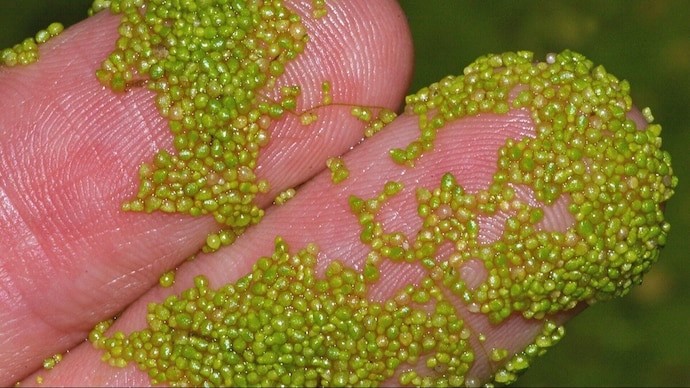Description

Disclaimer: Copyright infringement not intended.
Context
- Scientists from Mahidol University in Thailand have been exploring the potential of watermeal, the smallest flowering plant on Earth, as a source of nutrition and oxygen for astronauts.
Details
- Watermeal, the smallest flowering plant on Earth, is being explored as a potential source of nutrition and oxygen for astronauts by scientists from Mahidol University in Thailand.
- This research was conducted in collaboration with the European Space Agency's (ESA) ESTEC technical centre in the Netherlands.
Hypergravity Experiment
- The research involved subjecting watermeal to hypergravity conditions aboard ESA's Large Diameter Centrifuge (LDC), capable of simulating gravity levels up to 20 times that of Earth for extended durations.
- The goal was to understand how watermeal responds to changing gravity levels, which is essential for future space-based agriculture.
Watermeal Characteristics
- Watermeal is even smaller than its relative, duckweed, and lacks roots, stems, or leaves. It simply floats on bodies of water.
- Due to its simplicity and rapid growth rate, watermeal is an ideal candidate for studying the effects of gravity shifts on plant development.
Potential as Space Food
- Watermeal is a prolific producer of oxygen through photosynthesis and is rich in protein.
- It has been a part of the local diet in Thailand and other Asian countries, consumed in various forms such as soups and salads.
- Watermeal's high nutritional value and the fact that 100% of the plant can be consumed make it a promising candidate for space-based agriculture.
.jpg)
Experiment Details
- Watermeal samples were placed in boxes equipped with LEDs that mimic natural sunlight.
- These samples were then subjected to hypergravity conditions by spinning at 20 times Earth's gravity (20 g) in the centrifuge.
- The growth and development of watermeal under these conditions were observed over a two-week period.
- After the experiment, the researchers conducted a detailed chemical analysis on solid pellet extracts from the watermeal samples to understand how they responded to hypergravity.
Potential Insights and Applications
- The study is expected to provide valuable insights into how plants adapt to different gravity environments, which is crucial for sustainable agriculture in space.
- Watermeal's ability to produce oxygen and its high nutritional value make it a multifunctional candidate for future space missions.
- Understanding how watermeal responds to hypergravity can pave the way for developing space-based agriculture systems that provide both food and oxygen for astronauts.
About
- Watermeal, belonging to the genus Wolffia, is renowned as the smallest flowering plant on Earth.
- It is an aquatic plant that is often found floating on the surface of still bodies of water, such as ponds, lakes, and slow-moving streams.
- Despite its diminutive size, watermeal plays a significant role in aquatic ecosystems and has garnered attention for its potential applications beyond its natural habitat.
Key Characteristics of Watermeal:
- Size: Watermeal plants are incredibly small, typically measuring less than one millimeter in length. They are often described as tiny green specks that collectively form a floating mat on the water's surface.
- Appearance: Individual watermeal plants consist of a simple, flattened, and oval-shaped structure that lacks roots, stems, and true leaves. They are green in color due to the presence of chlorophyll.
- Reproduction: Watermeal reproduces asexually, primarily through budding. New plants emerge from the mother plant, and these daughter plants eventually separate to form independent individuals.
Ecological Significance:
- Habitat and Range: Watermeal is found in various parts of the world, with a particular concentration in tropical and subtropical regions. It thrives in slow-moving or still waters with abundant sunlight.
- Ecological Role: Despite its size, watermeal plays a crucial ecological role. It provides habitat and food for various aquatic organisms, including small invertebrates and waterfowl. Additionally, it contributes to nutrient cycling in aquatic ecosystems.
Potential Applications:
- Nutrient Removal: Watermeal has the ability to absorb excess nutrients, such as nitrogen and phosphorus, from water bodies. This property makes it a potential tool for water purification and the management of eutrophication in polluted waters.
- Sustainable Agriculture: As mentioned in the article, watermeal is rich in protein and can be a valuable source of nutrition. It is considered a potential candidate for sustainable agriculture, both on Earth and in space, due to its high nutritional value and rapid growth rate.
Space-Based Research:
- Hypergravity Experiments: Watermeal has been used in experiments involving hypergravity conditions to study its growth and development in altered gravitational environments. These experiments provide insights into how plants adapt to different gravity levels, essential for space agriculture.
- Oxygen Production: Watermeal is a proficient producer of oxygen through photosynthesis. This property makes it a potential oxygen source for long-duration space missions where life support systems are crucial
.jpg)
Conclusion
- Watermeal, Earth's smallest flowering plant, holds promise as a valuable resource for future space exploration, potentially serving as a nutritious food source and an efficient oxygen producer for astronauts. The research conducted by Mahidol University and ESA sheds light on the plant's adaptability to different gravity conditions, contributing to the development of sustainable space-based agriculture.
|
PRACTICE QUESTION
Q. Which of the following statements about watermeal (Wolffia spp.) is correct?
1. It is the largest flowering plant on Earth.
2. Watermeal is typically found in fast-flowing rivers.
3. It reproduces primarily through seeds.
4. Watermeal lacks roots, stems, and true leaves.
Choose the correct option:
A) 1 and 2
B) 2 and 3
C) 3 and 4
D) 2 and 4
Answer: D)
|












